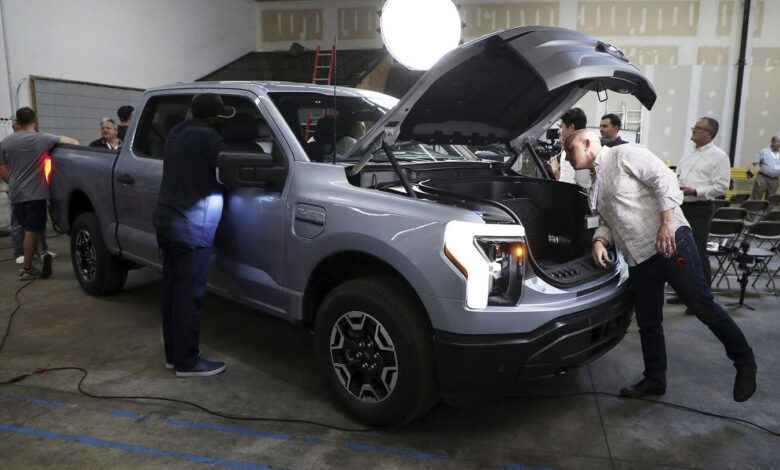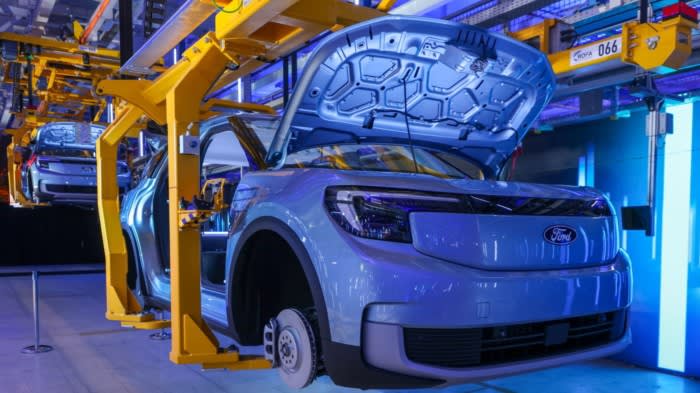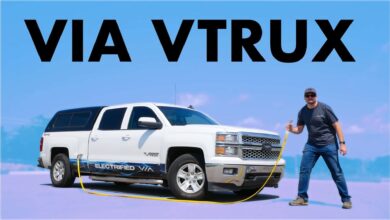Bidirectional Charging Will Empower Consumers And Enrich Automakers

Matthew McCaffree, right, of the energy and water resource management company Itron, looks at the … [+]
With summer coming, expect some brutally hot weather and treacherous thunderstorms—enough to knock out the grid. Furthermore, electricity usage is rising due to greater demand, increased use of electric vehicles, and more green electrons.
Enter bidirectional charging, which takes the power in EV batteries and sends it to the grid or homes and businesses. In other words, what goes in can also come out. General Motors
General Motors
“Bidirectional charging technology hasn’t been installed on most EVs yet and thus has been largely theoretical,” Nicole LeBlanc, partner at Woven Capital, Toyota’s growth fund, told me. “Expect that to change, as it’s on the product roadmap for most automakers over the next 2-3 years. It’s an exciting opportunity, but we should take caution as the grid is facing unprecedented challenges—from the influx of renewables to soaring demand for power. Expect utilities to test and phase in these new technologies to avoid chaos.”
Canadian wildfires ran wild last year, while a fire destroyed parts of Maui along with its network. Meantime, Colorado ended 2021 with a wildfire in the Boulder area that destroyed nearly 1,000 homes.
The United Nations said higher temperatures and changing land patterns cause more wildfires and polluted air. Climate change leads to warmer weather and more prolonged droughts that cause wildfires. Fifty scholars from six continents conclude that without severe mitigation, the risks from menacing blazes will increase by 57% by the century’s end.
Meantime, the grid is under more pressure. The Electric Reliability Council of Texas said power use reached 80,828 megawatts (MW) at 6 p.m. in late June 2023. That exceeds the previous record of 80,148 MW set on July 20, 2022.
Battery storage supplies electricity during stressful times. It boggles the mind that a car battery can send electricity to not just the transmission system but also a home or business. During the Texas freeze in 2021, someone used their Ford 150 to keep their house lit and warm.
Cars Will Keep The Lights On
LAGUNA HILLS, CA – SEPTEMBER 16: August 2020 was the hottest month on record in California according … [+]
That’s behind GM’s venture—to provide a “holistic EV ecosystem, helping to mitigate the impacts of power outages and having the ability to offset certain energy costs over time,” said Wade Sheffer, vice president of GM Energy. Research and Markets valued the global bidirectional EV charger market at $933 million in 2022. That number will hit $4,820.6 million by 2031.
Roughly 28 million electric vehicles will hit U.S. roads by 2030, storing more electricity than this country’s power plants. The battery storage in those vehicles is a valuable asset that could join in the collective aggregation strategy, supplying backup power if the primary network is down. For example, aggregators enlist corporate EV fleets willing to hold back during peak usage—an electricity bundle packaged and sold into energy markets.
To be clear, GM, Ford, and Volkswagen are making bidirectional batteries for homes, not the broader electricity market. Practical? “So far, it’s been too complex and costly for most consumers to deploy vehicle-to-grid charging at home,” Jason Massey, chief executive of Ndustrial told me.
However, the idea is making waves now. Not only is the weather squeezing the transmission system, but the automakers also have a trove of data tied to battery peformance. That means they expect bidirectional batteries to deliver.
“Automakers are also beginning to recognize a new revenue opportunity via bidirectional charging, as evidenced by the 2022 launch of GM Energy,” Kristian Bodek, Director at National Grid Partners, told me. We’re seeing more companies get in the game as a result of decisions like GMs.
“Industry leaders often discuss how bidirectional vehicles and chargers will enable vehicle-to-grid platforms that could translate into a very large source of distributed generation in the long term,” she adds. “We may well get there in the years to come, but I believe the starting point will be vehicle-to-home and vehicle-to-building where EVs serve primarily as both a resiliency and demand charge management solution.”
Boulder, Colorado is testing a vehicle-to-building technology, which takes electricity from EVs and feeds that into buildings. It is partnering with Fermata Energy, which has bidirectional charging systems, to reduce the city’s building energy costs. Fleet cars charge at night when the power demand is at its lowest and discharge during the day when electricity demand peaks.
The global economy is decarbonizing and driving the growth of EVs—spawning the bidirectional directional charging buzz, which will empower consumers and prevent wear and tear on the grid. That’s vital, given the rate of extreme weather events and the expected rise in electricity demand.



